Turkish Baklava, also known as Fistikli Baklava or Pistachio Baklava, is a deliciously rich, buttery, sweet dessert made from phyllo dough, finely ground pistachios, butter, and a syrup made from sugar, water and lemon juice. That’s it!

I lived in Istanbul for six years and love Turkish baklava! This recipe is great… once I used finely ground walnuts and it worked just as well.
Thank you! ~ Celeste
Last year during Christmas Cookies Week, I shared a Greek baklava recipe, which we LOVED. And apparently you did as well, because I had so many readers come to my site for that post! It’s full of walnuts and sweetened with a honey syrup and is just so, SO good.
But this year, I thought I would make this Turkish baklava recipe to showcase some of the similarities and differences between the recipes!
Right after graduating law school and taking the California bar exam, Paul and I took off on a backpacking trip around parts of Europe, Asia, and Africa. Two of the countries we stopped in were Greece and Turkey.
We loved them both deeply, and are agreed that Turkey, especially, is one of our favorite countries we have ever visited.
Let’s throw it back with a photo collage of three of my favorite spots in Turkey – Cappadocia, Pammukale, and Istanbul. 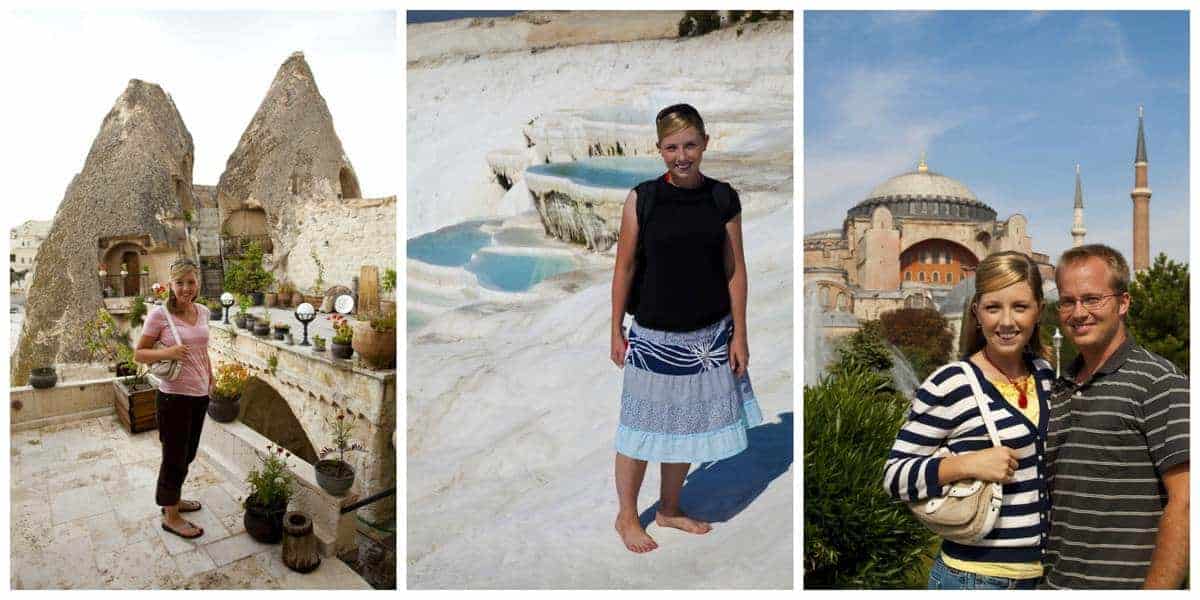 Without going too deep into history and culture, one thing we learned while we were traveling between the two countries is that their history has been fraught with confrontation and there has been fighting between the two for centuries.
Without going too deep into history and culture, one thing we learned while we were traveling between the two countries is that their history has been fraught with confrontation and there has been fighting between the two for centuries.
It was more than a little awkward a time or two when guides from either country would start openly criticizing the other country and giving a very skewed account of the history of what had happened between the neighboring countries during periods of time. But there have been periods where many Greeks have lived in Turkey and many Turks have lived in Greece, and there has been crossover between them.
Enter baklava.
Greek Baklava vs. Turkish Baklava
I don’t think anybody really knows where it was invented or who, really, can claim ownership over it. But I know that both countries have strong baklava traditions that even vary within the country from place to place.
So I’m aware that I’m somewhat over-generalizing here by saying that Greek baklava uses honey, walnuts, and cinnamon, while Turkish baklava uses a sugar syrup, pistachios, and lemon juice without the addition of spices or other flavors.
Good baklava is sweet, but not cloying, and moist, but not soggy, regardless of where it’s from (although I do think that Turkish baklava is typically more wet than Greek baklava in my experience).
There are also differences in how the baklava is cut and presented, but for the sake of keeping things simple, let’s just go with the distinctions I’ve already made. Is that okay?
If you enjoy baklava, I think you would also love these other nutty desserts! Be sure to check out our Candied Almonds, Maple Walnut Ice Cream, and Burnt Almond Cupcakes.
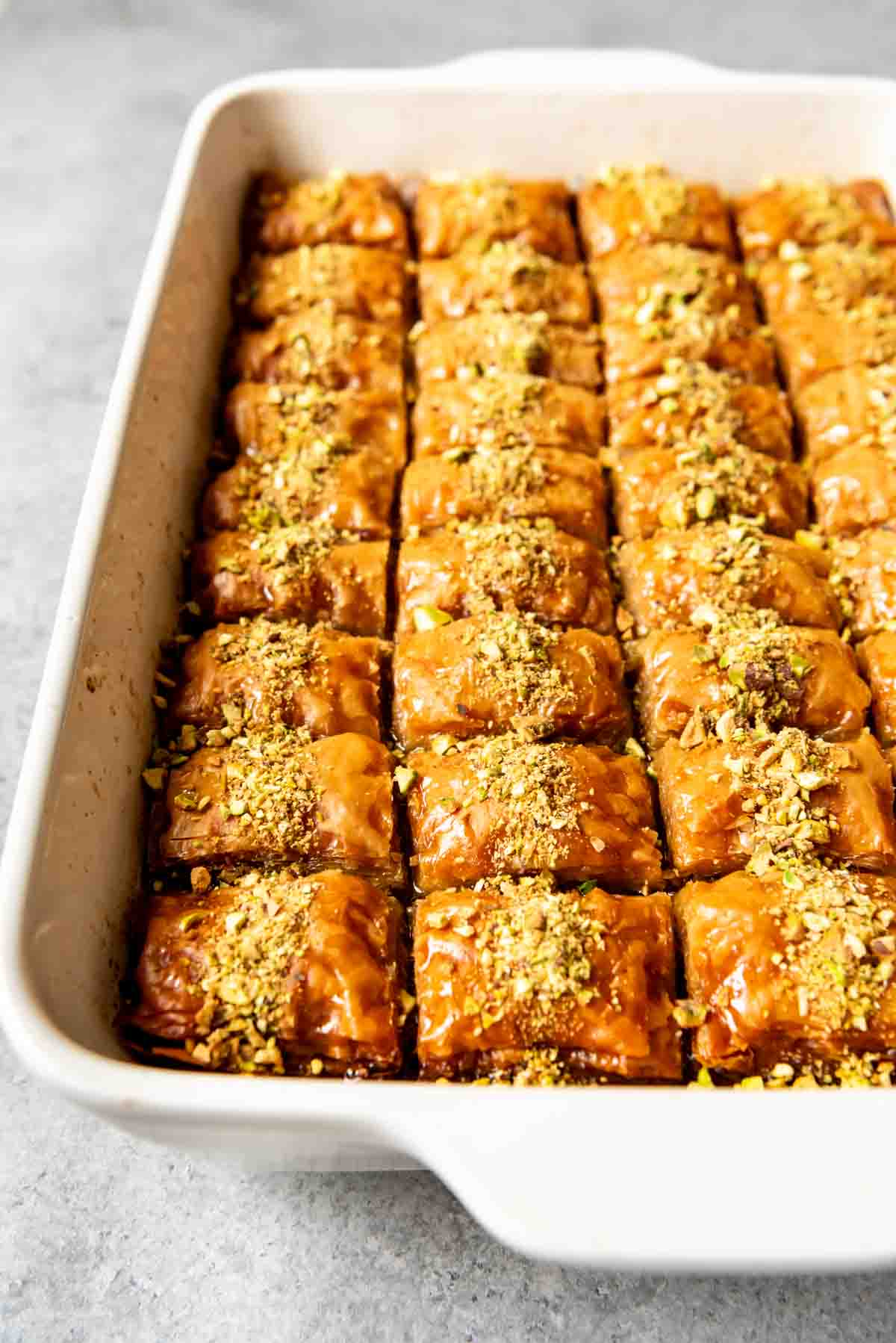
Pistachio Baklava
When it comes to Turkish baklava, I strongly feel that pistachio nuts are the way to go. I just love their flavor and vibrant green color that is so unlike any other nut!
Sure, some places in Turkey use almonds, or a combination of pistachios and walnuts, but from what I have seen and read, it really seems like classic pistachio baklava is the way to go if you are trying to create authentic Turkish baklava.
Turkish baklava is also unique in that it doesn’t use any honey as a sweetener or to provide flavor. Instead, a thick syrup is made from nothing more than sugar, water, and a little lemon juice, which adds both flavor and helps prevent crystallization of the sugar.
But besides those two major distinctions, baklava from either country is similar. It’s made from thin phyllo dough that is layered in a large baking dish one sheet at a time, brushing melted clarified butter between each sheet to build up the distinctive flaky texture that baklava is known for.
8 to 10 sheets of butter-brushed phyllo build the base of the baklava in the pan, then a good amount of finely chopped nuts is spread evenly before topping with another 8 to 10 sheets of phyllo and butter, more nuts are added, and the remaining phyllo is added to finish things off.
It’s a little different from how I layer my Greek baklava where I do more layers of nuts between fewer layers of phyllo, but both approaches work equally well.
How to Make Turkish Baklava
- Thaw a box of frozen phyllo dough in the refrigerator overnight.
- Make the sugar syrup for the baklava by combining the sugar and water in a saucepan and bringing to a boil. Lower the heat to a simmer and let the syrup thicken for 20-25 minutes until golden and thick. Remove from heat and stir in the lemon juice, then cool completely and refrigerate until ready to use. You want the syrup to be cold when it’s time to pour it over the baklava.
- When ready to make the baklava, preheat the oven to 350° F and brush a 9×13-inch baking dish with clarified butter. Unroll the thawed phyllo dough and cut to fit the pan, if needed. My 16-ounce package of phyllo dough came in 18 sheets that were 13×17-inches, so I just cut the entire stack in half so they fit, which gave me 36 sheets to work with. Really more like 33-ish since I almost always destroy a couple of phyllo sheets along the way.
- Keep the phyllo covered with a damp cloth while stacking the baklava so that it doesn’t dry out. Gently lay 1 sheet of phyllo down in the bottom of the buttered pan and use a pastry brush to drizzle and brush some of the clarified butter to coat the sheet of phyllo. Repeat with another 8-9 sheets of phyllo dough, brushing with butter each time. It’s reminds me of doing modge-podge, if you have any experience with that. (My only experience with modge-podge is from Girls’ Camp, but it’s what I always think of when making baklava). The first couple of sheets might want to fold up on you, but once you have two layers or so, it gets easier as there is more base built for the new phyllo sheets to cling to.
- Sprinkle half of the finely ground or chopped pistachios evenly over the built up bottom layers of phyllo dough, then repeat the process with another 10 sheets of phyllo dough and clarified butter, melting the butter in the microwave if it starts to cool down too much and firm up.
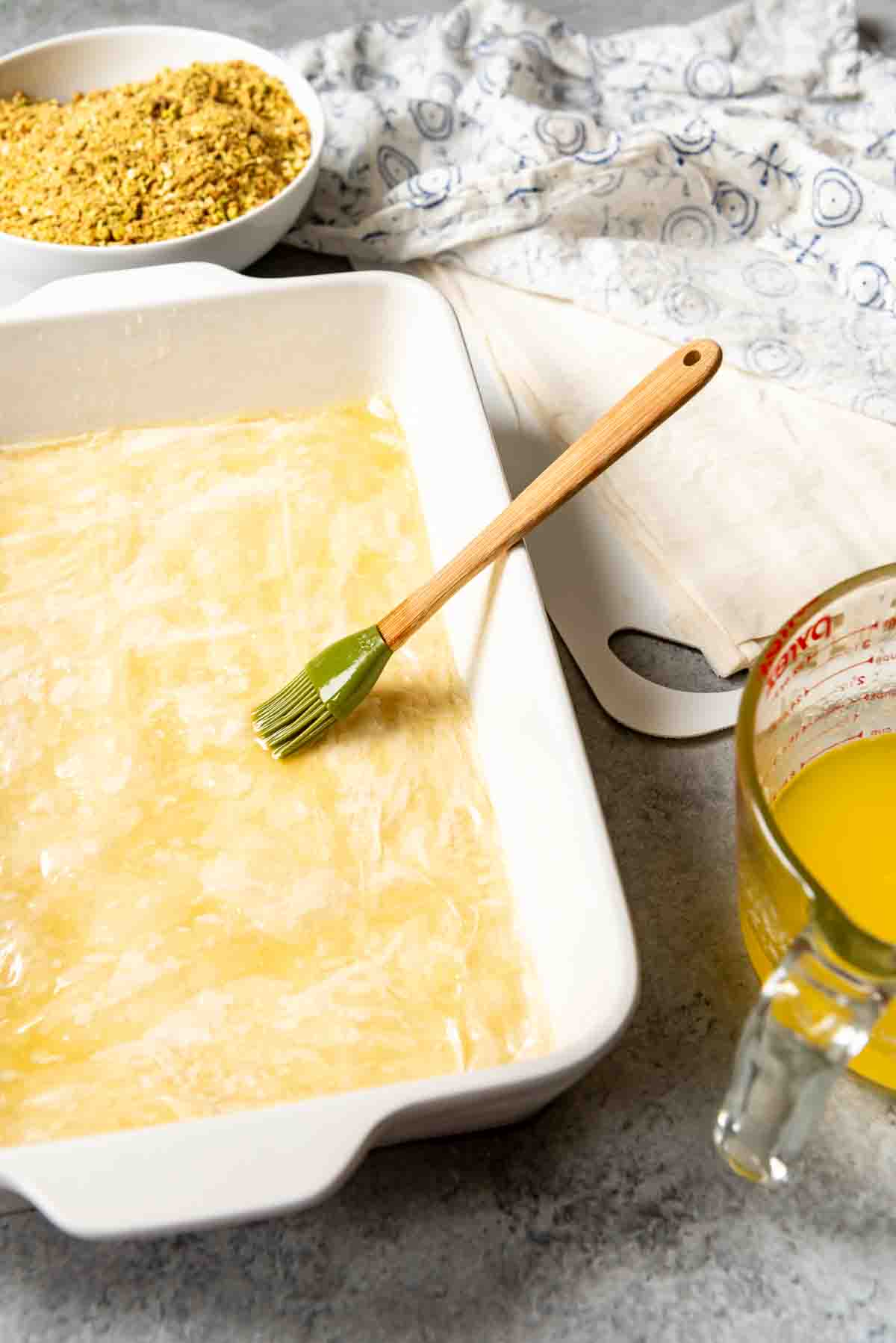

- Add the remaining ground nuts, then finish assembling the baklava by creating the top layer with any remaining sheets of phyllo dough and butter. My top layer ended up being 13 phyllo sheets thick. Brush the top layer with the last of the butter.
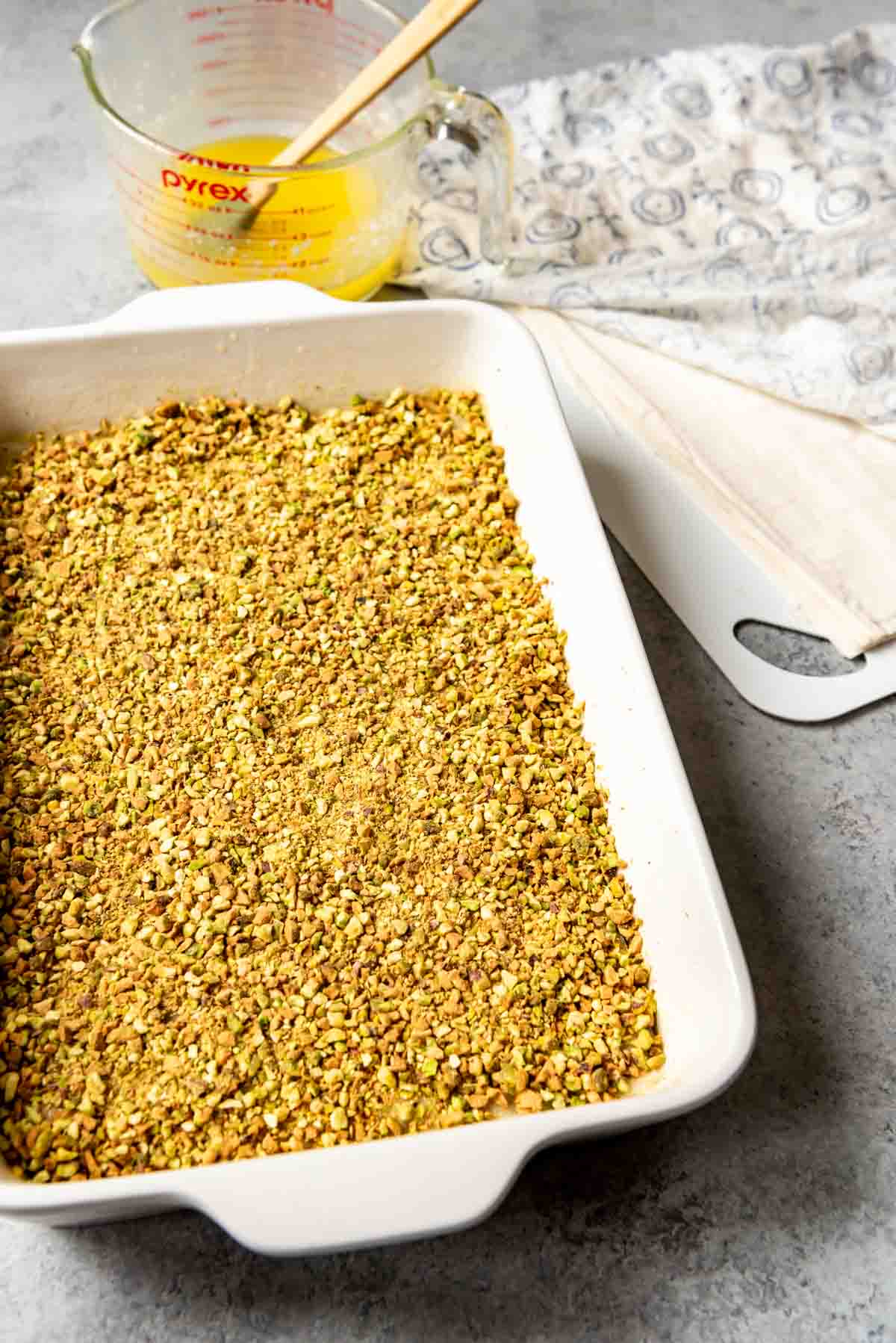

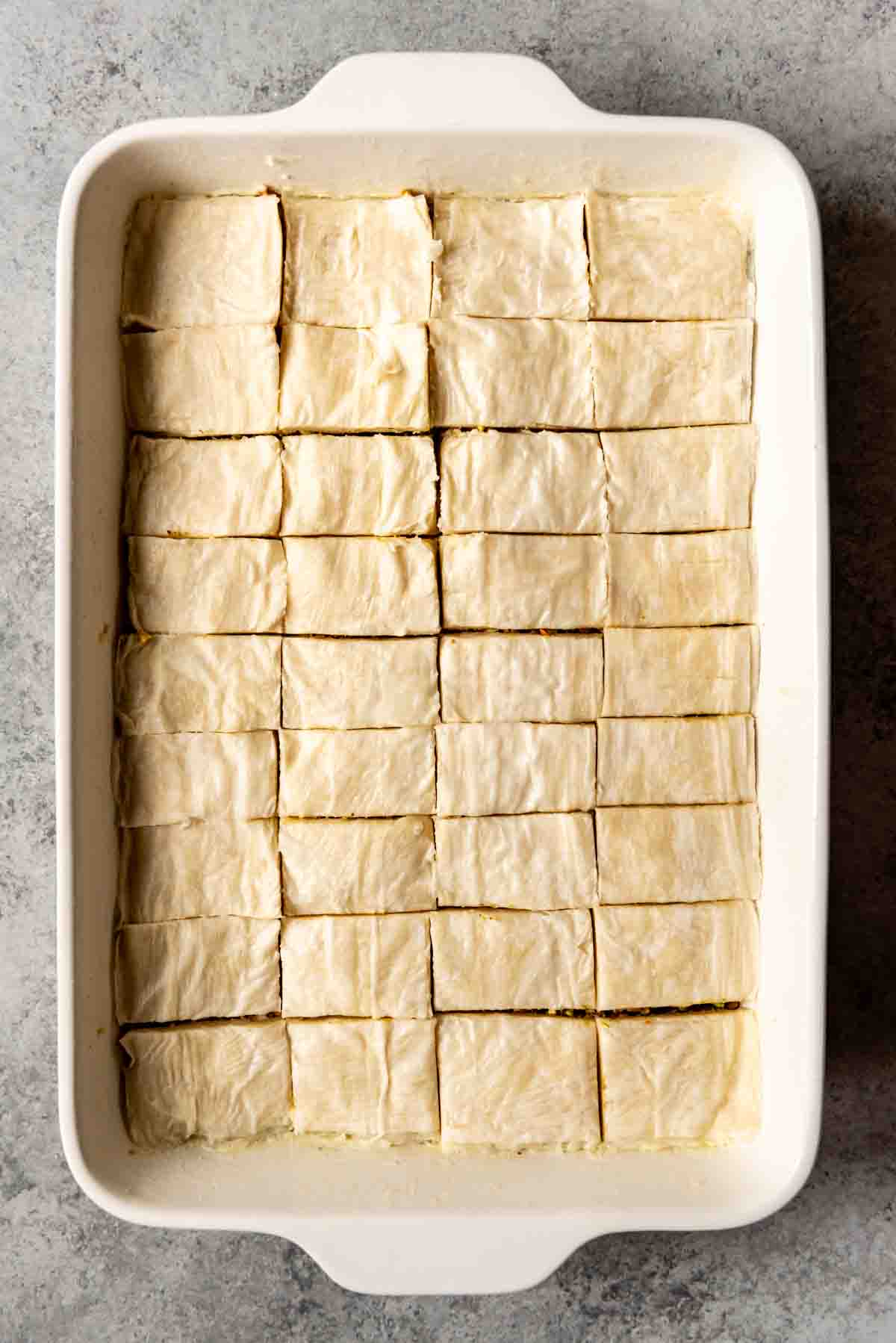
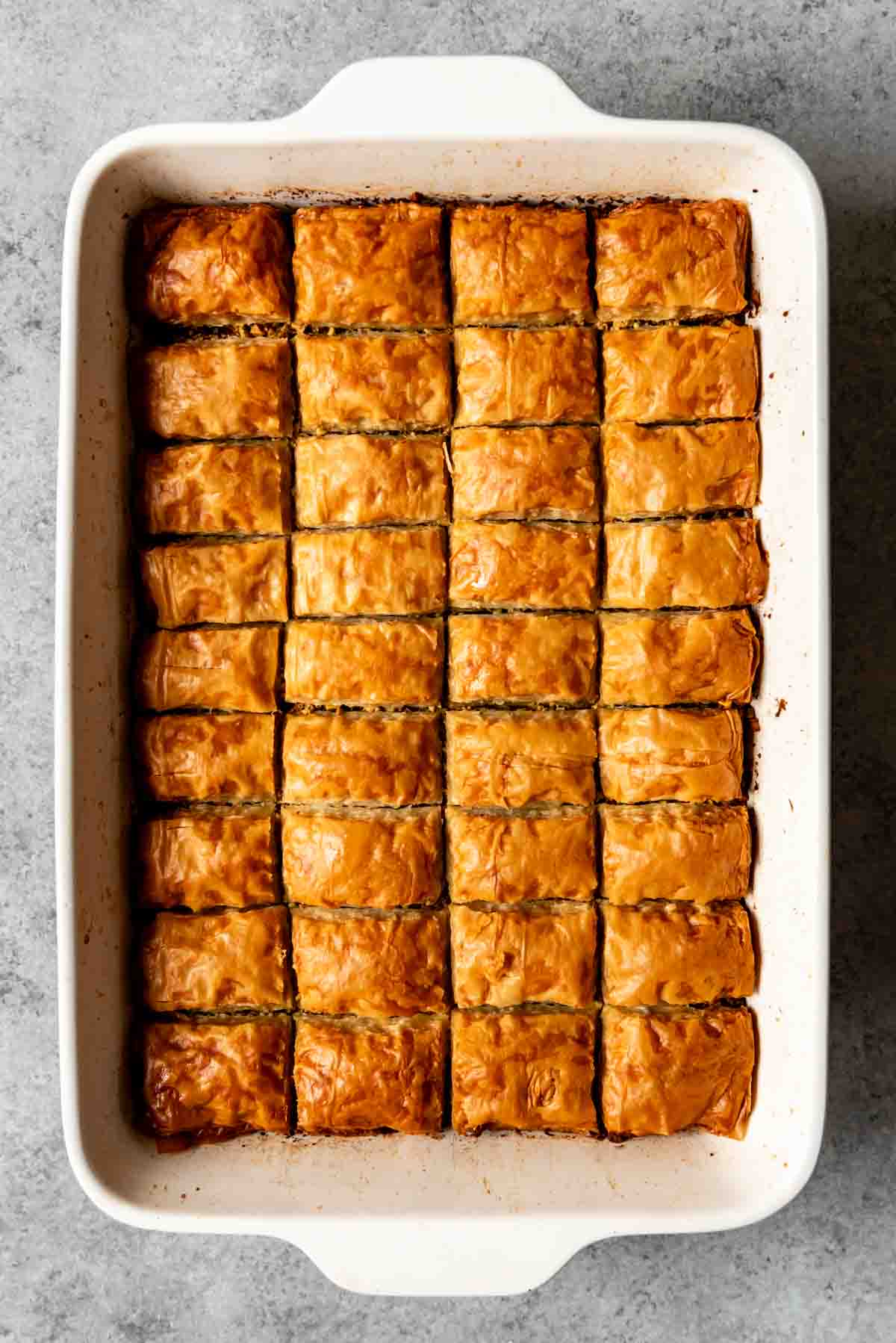
- Use a very sharp knife to cut through the uncooked baklava in a rectangular pattern to make 36 baklava servings. Be sure to cut all the way through to the bottom layer! Bake for 1 hour until golden brown on top and the bottom layers are cooked through. Check the baklava around 40 minutes and if it is browning too much, cover with heavy duty aluminum foil for the remaining bake time.
- As soon as the baklava is done baking, remove it from the oven and slowly pour the cooled syrup over the hot baklava, being careful as it can bubble up as the cold syrup hits the hot pan. You don’t have to use all the syrup if you feel like it’s too much or your baklava is too wet. It’s important to have the temperature differences though as it keeps the baklava from getting soggy, which is what happens if you pour cooled syrup over cooled baklava. Sprinkle the baklava rectangles with finely ground pistachios on top.
- Let the baklava sit for at least 1 hour to soak up the syrup. If the baklava doesn’t soak up all the syrup, don’t worry too much. Like I mentioned before, most of the Turkish baklava I have had has seemed wetter than other types of baklava. Just pour off any excess syrup that doesn’t get absorbed and transfer the baklava rectangles to a serving plate.

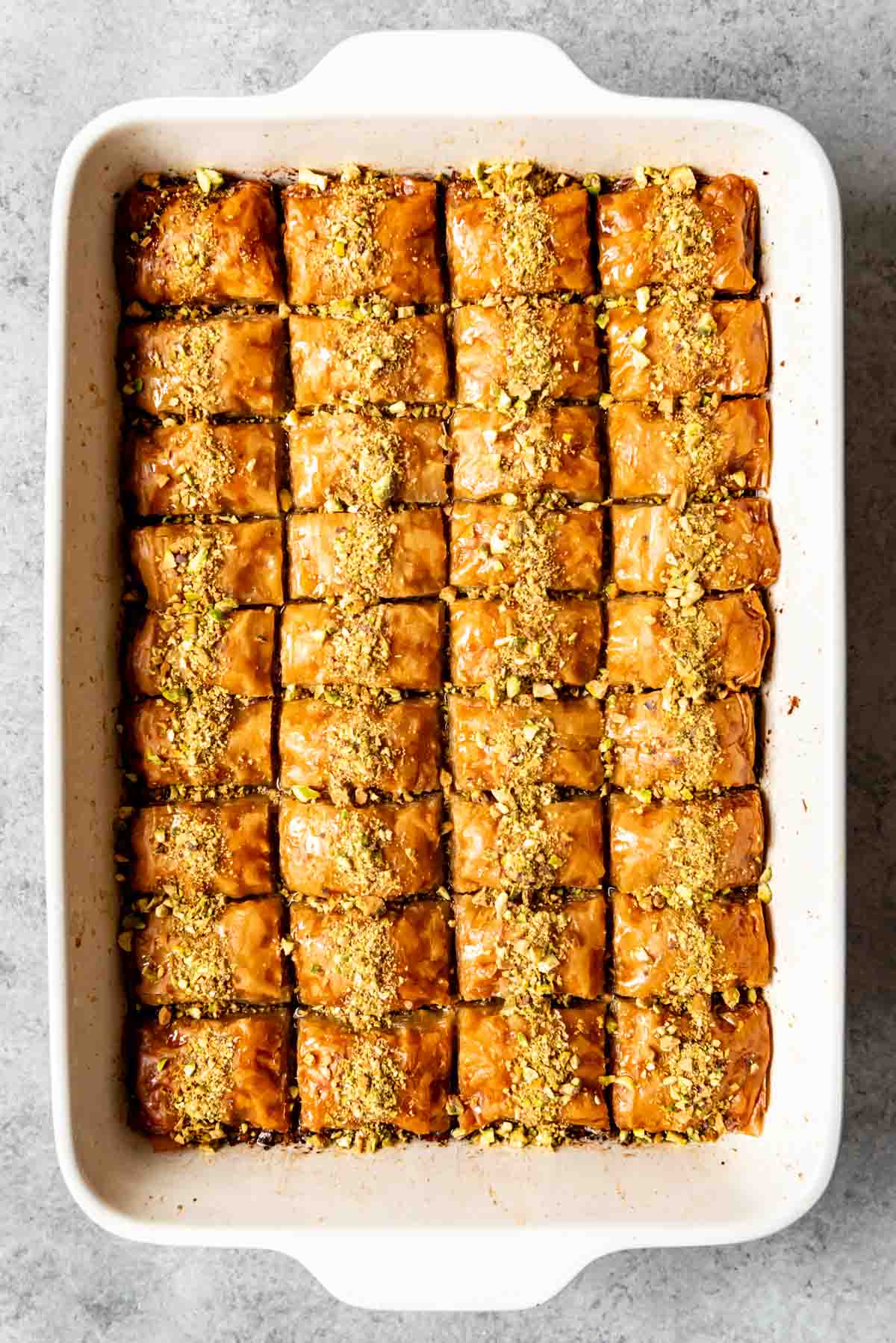
How to Make Clarified Butter
This recipe calls for clarified butter, which is just melted butter that has the milk solids (the foam on top and the white solids at the bottom) removed. I actually don’t know that I notice a difference between using clarified butter or just using regular melted butter in baklava.
But for the sake of authenticity, I went ahead and clarified my butter for this recipe. It’s really easy to do. Here’s how:
- Melt 1 pound of butter in a saucepan over low heat. No need to stir, really. The melted butter will separate into 3 layers: foamy froth on top, clear yellow liquid in the middle and white solids at the bottom.
- When the butter is completely melted and the foam has formed, remove the pan from the heat.
- Scoop the foam off the top with a spoon and discard.
- Keep the yellow middle layer by decanting it from the saucepan without removing the milk solids or by straining it through cheesecloth.
I always do my best to research recipes from other cultures thoroughly to represent them as best I can. If this recipe is from your country or culture and you have suggestions for how I can improve its authenticity, please let me know in the comments below! It’s important to us to share beloved foods of other cultures with as much accuracy as possible, while also considering things like accessibility of ingredients and ease of preparation for most home cooks.
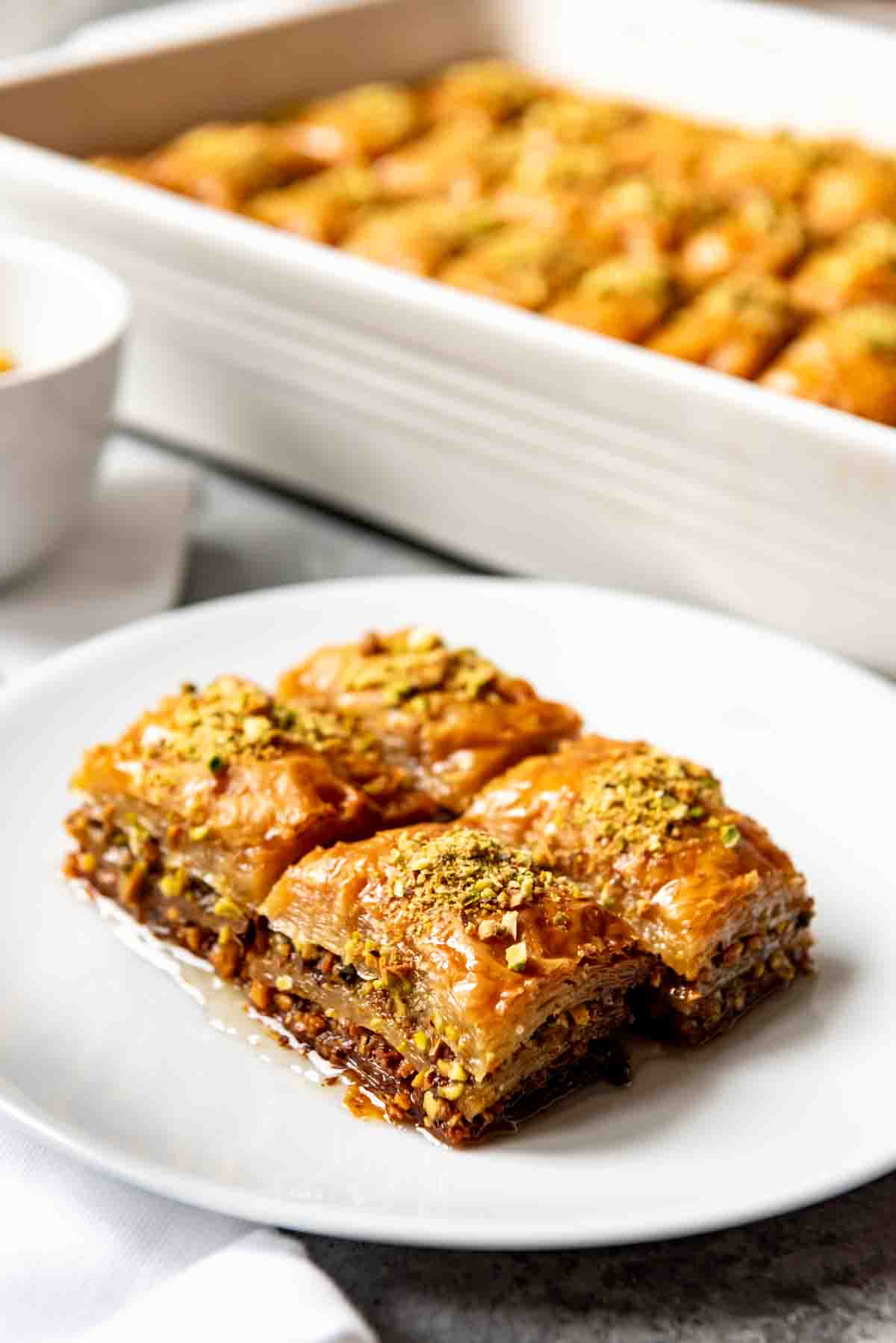
How ‘Bout a Little More Baklava? Here are some less traditional Baklava Variations:
More Dessert Recipes
Turkish Baklava
Ingredients
Syrup
- 3 cups granulated sugar
- 1 2/3 cups water
- Juice of ½ lemon
Baklava
- 1 pound Phyllo defrosted overnight in the refrigerator
- 3 cups shelled pistachios finely chopped
- 1 1/2 cups clarified salted butter
- 1/3 cup shelled pistachios finely chopped
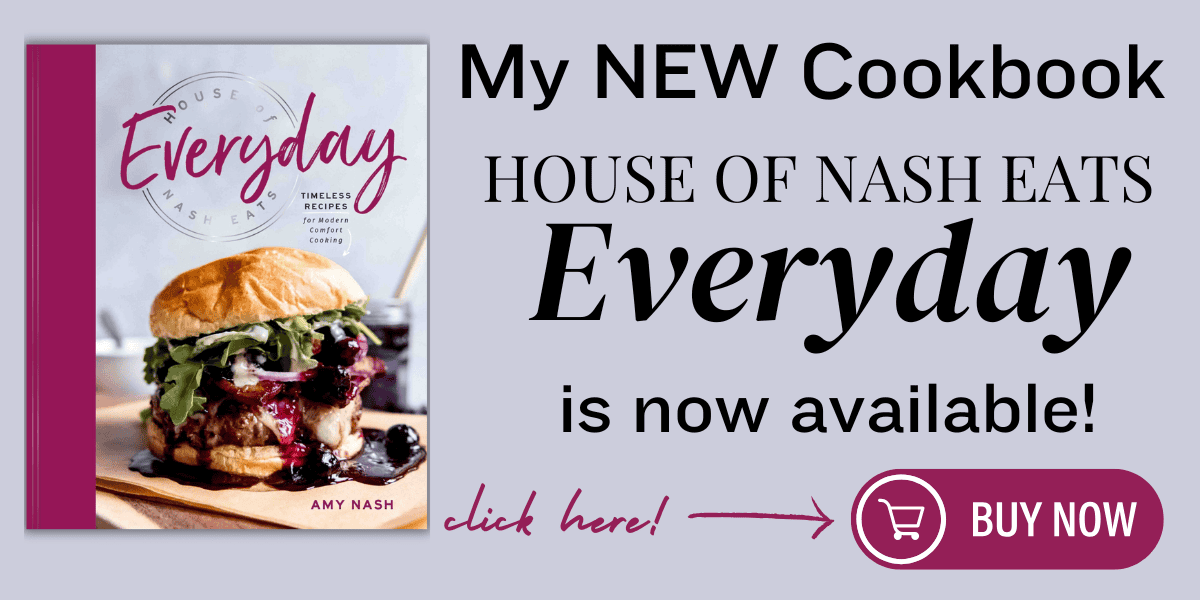
Instructions
- In a medium pot, combine the sugar and water over medium-high heat. Bring to a boil, then reduce the heat to medium-low and simmer for 20-25 minutes, until slightly thickened and golden in color. Stir in lemon juice, then cool completely in the fridge until ready to use.3 cups granulated sugar, 1 2/3 cups water, Juice of ½ lemon
- Make the clarified butter (see explanation in post for more information on how to do this) and finely chop the pistachios. Heat oven to 350°F and brush a 9×13-inch baking dish clarified butter.1 ½ cups clarified salted butter
- Trim the phyllo dough to fit the baking dish, if needed, and cover with a damp kitchen towel to keep it from drying out while assembling the baklava. Carefully separate 1 sheet of phyllo from the stack and lay it on the bottom of the baking dish. Brush the phyllo sheet lightly with clarified butter.1 pound Phyllo
- Continue to layer 8-9 more phyllo sheets on top, brushing each sheet with butter until 10 sheets of phyllo have been stacked in the bottom of the baking dish. Sprinkle ½ of the chopped pistachios over the phyllo base in an even layer.3 cups shelled pistachios
- Repeat the process to create another 8-10 sheet layer of phyllo and butter, followed by the remaining ½ of the nuts, and another top layer made up of the remaining phyllo sheets and butter. Slice into 36 pieces with a sharp knife, making sure to always cut through all layers of phyllo.
- Bake for 60 minutes, until the top is golden brown, and the bottom phyllo layers are baked through. Use a knife to lift up a corner of one of the rectangles to see if the bottom layers are done. Check the baklava after 40 minutes and cover with a piece of foil over the top if the baklava is getting too browned.
- When the baklava is done, remove from oven and slowly pour the cold syrup over the hot baklava. The syrup will likely bubble up and some may even overflow. Sprinkle the top of each piece of baklava with the remaining finely chopped pistachios.⅓ cup shelled pistachios
- Let the baklava cool completely before serving at room temperature.



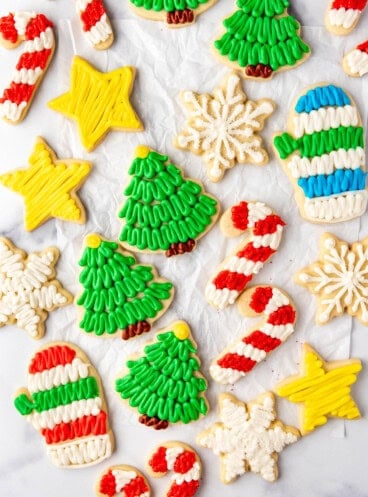
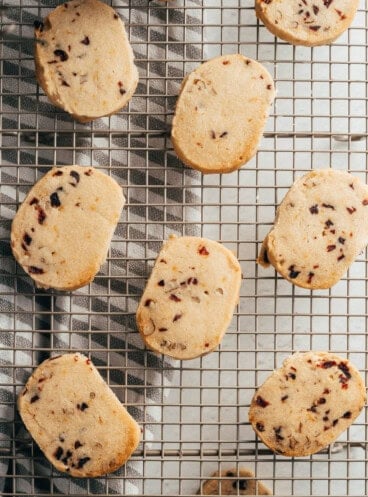
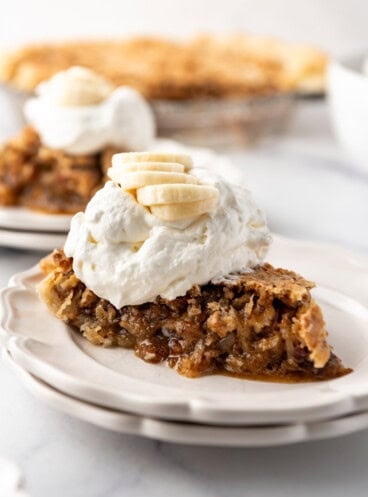

Amy, Paul brought some of this to the office. Everyone raved about it. It was probably the first time I sampled fresh Baklava. It was truly amazing and we all really enjoy sampling your wonderful recipes! Thanks
Aww, thank you, Dana! I’m so glad you enjoyed it! I’m going to have to keep sending things in with him!
This is delicious! I made it with half walnuts and half pistachios, and it turned out great! I do like your greek baklava recipe slightly better but this is almost just as good.
I think the Greek version is my favorite too, but everybody at my husband’s office went nuts over this one! They are both really delicious though.
Straightforward recipe, learned to make clarified butter for this one. Handing the phyllo was easier than expected. My only issue was making the syrup, which was light golden, but when cooled, it was very hard… Turned all my black into half hard candy. May need a candy thermometer
Yes, it sounds like the syrup was cooked too long.
Do not let the syrup become colored. It must be completely colorless and transparent. Lower the temperature and reduce the syrup cooking time.
very nice ,thank you
Thank you for the Turkish baklava recipe. It’s a really useful recipe. I had looked at some recipes before, but I couldn’t do it properly. I follow your posts.
The reason that clarified butter is used in baklava is that the milk solids will burnduring the baking process and could leave unsightly marks on the surface of the finished product. Clarified butter has a much higher smoking point than regular butter.
I am of Armenian descent and my ancestors (survivors from Turkey) used cinnamon and sugar mixed with the nuts. Though they used pistachios, we now prefer pecans, and add the nut mixture at every 4 layers of filo, not just in the middle. We, too, use a simple syrup for moisture and flavor (not honey), and follow the steadfast rule, hot syrup over cold pakhlava (baklava) or cold syrup over hot pakhlava. And our pakhlava is always cut into diamonds, for good luck, according to my great aunt.
Finally, I’ve heard so many disagreements regarding the origins of middle-eastern and eastern European dishes that it’s helpful to remember that these foods belong to a broad region rather than a particular nation. When different cultures share the same spices, resources, and access to shipping, they are more likely to utilize similar products in their traditional cooking, varying a flavor from here to there; our Lebanese neighbors add a surprise chick pea to each of their rice-and- onion-stuffed grape leaves, something Armenians (of Turkey) would never do. It’s their thing. I still love stuffed grape leaves and consider then mine.
Thank you so much for posting this recipe. The pistachios on top add such a beautiful splash of color that I might even use them for my Christmas pakhlava. ;]
Thank you for such a thoughtful, thorough comment and explanation! I’m glad you were inspired by the pistachios on top! I do the nut mixture every 4 layers rather than just in the middle in my Greek baklava and love that approach as well.
Nice recipe and closer to Turkish baklava than some I’ve seen, and thanks for recommending clarified butter! It makes such a beautiful top.
But to be a bit of a curmudgeon here 🙂 you can’t really do Turkish baklava justice if you use store-bought phyllo (yufka). The best Turkish yufka has egg in the dough, and is rolled out much thinner than the commercial product, which tends to be too dry to puff and separate to make that delicate crispness that is the soul of the pastry. Rolling your own phyllo is a technique that takes some practice but is not as difficult as it might appear.
However if you have a good Middle Eastern grocery near you, you might be able to get phyllo made especially for baklava. It’s still not as good as handmade but it will get you a lot closer!
Also – there’s no need to brush butter on every sheet. A little oil on the bottom of the pan and butter sprinkled between the first few layers helps them separate better there. But after that? Just stack the dough and nuts the way you like, cut the baklava, and pour the clarified butter over the top. It will soak in.
Another important point: Put the baklava on the lower rack of the oven. You want it to cook slowly and really thoroughly. It doesn’t have to be extremely brown; it should be light and delicately browned. (And a browned top is not an indication that the baklava is really done.) The main reasons for baklava getting soggy are syrup that is too thin, and undercooked dough in the middle.
If your baklava is completely cooked and the syrup is thick enough, there is no need to worry about hot baklava/cold syrup etc. Just take it out of the oven and out that hot syrup on.
Thank you so much for your detailed, thorough, and thoughtful comment!
Looks very easy to prepare. I discovered Turkish Baklava on my Istanbul visit last year. I fell in love with the taste and texture of this sweet. I have found good Turkish Baklava varieties online but this time, I will try to make my own Turkish Baklava at home. Thanks millions!! : )))
Love, LOVE this amazing, thorough post and all of the comments which are equally helpful! I’ll be making this in two days’ time for my husband’s birthday/new year’s Eve party. I’m curious…. Salted or unsalted pistachios? Roasted or raw? Again thank you so much! -renee
I used the roasted salted pistachios from Costco. You could use unsalted too, but I would not recommend using raw pistachios.
It is really good recipe and explanatory post about the differences and similarities of Greek and Turkish baklava. My grandma generally made baklava with walnuts and we love it. By the way, I want to try Greek version one day. 🙂 Thank you for your positive and tasty sharing!
I lived in Istanbul for six years and love Turkish baklava! This recipe is great… once I used finely ground walnuts and it worked just as well.
Thank you!
I’m so glad you love it!
It was a HIT at the Christmas around the world party! My husband’s brother in law said they looked and tasted professionally made! Definitely try this recipe!
Can you make this with honey
Yes, but using honey is leaning more towards a Greek Baklava while a Turkish baklava is unique in that it doesn’t use any honey as a sweetener or to provide flavor. Instead, a thick syrup is made from nothing more than sugar, water, and a little lemon juice. Here is my Greek Baklava if you want to check it out though! https://houseofnasheats.com/greek-baklava-recipe/
First thank you for posting the careful instructions as well as the backstory and variations. I bake often but I have never made baklava. I have been on a pistachio binge and had a package of phyllo in my freezer that has been waiting so I looked up what I can make with both I found your recipe. When it comes to prep time, I found this to take waaaay longer than 30 min. Just the syrup took 30 min. I was going to make it after work but decided to wait until the weekend. I’m glad I made on Saturday so it was my art project for the day. I didn’t feel comfortable to do the syrup and the butter at the same time because it was the first time making this I wanted to make sure to pay attention and not burn something. Someone who has done this before probably is fine to multitask. This whole thing took 5hrs for me + 1 hr bake time. I do clean as I go and used the same pan for the syrup and butter so I was washing the pan between things and I spilled some of the chopped nuts so I had to vacuum those up so…. And I did have to watch a couple of videos on making clarified butter, I didn’t want to accidently make brown butter. And I did try the cheesecloth method to remove the milk solids but that didn’t seem to work. Looking back maybe I should have let it cool more. It settled so I just used the yellow part on top. So if I were to make again I could probably shave it down to 2hrs prep. I have been cutting back on sugar in my diet so 3 c sugar seemed excessive but that is why I like this treat because it is combined with the fat in the butter and nuts. That saidI didn’t use all of the syrup. It tasted fine, I did eat it but I don’t think I will make it again. I did research if raw or roasted/salted pistachios were better and seemed that the raw was preferred so I used those but now thinking about it, the salt might have brought out the flavors better. Let me know if you have a preference. I’m glad I tried it, maybe down the road I might try a different type of baklava perhaps with honey but too much work for a quick sweet treat. After all that work it did look very fancy and had perfect browning. I will keep your website bookmarked 🙂 Thanks
My husband is Turkish and he said this is amazing!
Made this and it was fantastic. I didn’t think I would like the simple syrup in place of honey, but it was perfect. My kids want me to make it again and I only made it a week ago!
Thank you so much Sheila! I am happy to hear that your kids loved the Baklava!
How hot should the oven be??
In the post and on the recipe it says to heat the oven to 350 degrees F. Let me know if you have any more questions!
Love it
Thank you!